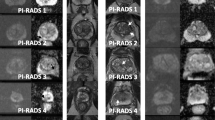Abstract
The most recent edition of the prostate imaging reporting and data system (PI-RADS version 2) was developed based on expert consensus of the international working group on prostate cancer. It provides the minimum acceptable technical standards for MR image acquisition and suggests a structured method for multiparametric prostate MRI (mpMRI) reporting. T1-weighted, T2-weighted (T2W), diffusion-weighted (DWI), and dynamic contrast-enhanced (DCE) imaging are the suggested sequences to include in mpMRI. The PI-RADS version 2 scoring system enables the reader to assess and rate all focal lesions detected at mpMRI to determine the likelihood of a clinically significant cancer. According to PI-RADS v2, a lesion with a Gleason score ≥7, volume >0.5 cc, or extraprostatic extension is considered clinically significant. PI-RADS v2 uses the concept of a dominant MR sequence based on zonal location of the lesion rather than summing each component score, as was the case in version 1. The dominant sequence in the peripheral zone is DWI and the corresponding apparent diffusion coefficient (ADC) map, with a secondary role for DCE in equivocal cases (PI-RADS score 3). For lesions in the transition zone, T2W images are the dominant sequence with DWI/ADC images playing a supporting role in the case of an equivocal lesion.










Similar content being viewed by others
References
Cancer Facts and Figures (2016) Atlanta: American Cancer Society; 2016 [cited 2016 2/11/2016]
Etzioni R, Penson DF, Legler JM, et al. (2002) Overdiagnosis due to prostate-specific antigen screening: lessons from US prostate cancer incidence trends. J Natl Cancer Inst 94(13):981–990
Schoots IG, Roobol MJ, Nieboer D, et al. (2015) Magnetic resonance imaging-targeted biopsy may enhance the diagnostic accuracy of significant prostate cancer detection compared to standard transrectal ultrasound-guided biopsy: a systematic review and meta-analysis. Eur Urol 68(3):438–450
Epstein JI, Feng Z, Trock BJ, Pierorazio PM (2012) Upgrading and downgrading of prostate cancer from biopsy to radical prostatectomy: incidence and predictive factors using the modified Gleason grading system and factoring in tertiary grades. Eur Urol 61(5):1019–1024
Penzkofer T, Tuncali K, Fedorov A, et al. (2015) Transperineal in-bore 3-T MR imaging-guided prostate biopsy: a prospective clinical observational study. Radiology 274(1):170–180
Rifkin MD, Zerhouni EA, Gatsonis CA, et al. (1990) Comparison of magnetic resonance imaging and ultrasonography in staging early prostate cancer. Results of a multi-institutional cooperative trial. N Engl J Med 323(10):621–626
Barentsz JO, Richenberg J, Clements R, et al. (2012) ESUR prostate MR guidelines 2012. Eur Radiol 22(4):746–757
Hamoen EH, de Rooij M, Witjes JA, Barentsz JO, Rovers MM (2015) Use of the prostate imaging reporting and data system (PI-RADS) for prostate cancer detection with multiparametric magnetic resonance imaging: a diagnostic meta-analysis. Eur Urol 67(6):1112–1121
Hansford BG, Peng Y, Jiang Y, et al. (2015) Dynamic contrast-enhanced MR imaging curve-type analysis: is it helpful in the differentiation of prostate cancer from healthy peripheral zone? Radiology 275(2):448–457
Platzek I, Borkowetz A, Toma M, et al. (2015) Multiparametric prostate magnetic resonance imaging at 3 T: failure of magnetic resonance spectroscopy to provide added value. J Comput Assist Tomogr 39(5):674–680
Tan CH, Hobbs BP, Wei W, Kundra V (2015) Dynamic contrast-enhanced MRI for the detection of prostate cancer: meta-analysis. AJR Am J Roentgenol 204(4):W439–W448
Weinreb JC, Barentsz JO, Choyke PL, et al. (2016) PI-RADS prostate imaging— reporting and data system: 2015, version 2. Eur Urol 69(1):16–40
Barentsz JO, Weinreb JC, Verma S, et al. (2016) Synopsis of the PI-RADS v2 guidelines for multiparametric prostate magnetic resonance imaging and recommendations for use. Eur Urol 69(1):41–49
Muller BG, Shih JH, Sankineni S, et al. (2015) Prostate cancer: interobserver agreement and accuracy with the revised prostate imaging reporting and data system at multiparametric MR imaging. Radiology 277(3):741–750
Rosenkrantz AB, Oto A, Turkbey B, Westphalen AC (2016) Prostate imaging reporting and data system (PI-RADS), version 2: a critical look. AJR Am J Roentgenol 206(6):1179–1183
Rosenkrantz AB, Kim S, Lim RP, et al. (2013) Prostate cancer localization using multiparametric MR imaging: comparison of prostate imaging reporting and data system (PI-RADS) and likert scales. Radiology 269(2):482–492
Schimmöller L, Quentin M, Arsov C, et al. (2013) Inter-reader agreement of the ESUR score for prostate MRI using in-bore MRI-guided biopsies as the reference standard. Eur Radiol 23(11):3185–3190
Kasel-Seibert M, Lehmann T, Aschenbach R, et al. (2016) Assessment of PI-RADS v2 for the detection of prostate cancer. Eur J Radiol 85(4):726–731
Rosenkrantz AB, Ginocchio LA, Cornfeld D, et al. (2016) Interobserver reproducibility of the PI-RADS version 2 Lexicon: a multicenter study of six experienced prostate radiologists. Radiology. doi:10.1148/radiol.2016152542
Hassanzadeh E, Olubiyi OI, Fedorov A, et al. (2016) Comparison of performance of quantitative ADC versus PI-RADS v2 assessment for differentiating high-grade from low-grade prostate cancer. ISMRM 24th Annual Meeting. Singapore
Acknowledgements
Grant funding provided by the National Institutes of Health Grant Number: U01CA151261 (FMF), the National Institutes of Health Grant Number: R25CA89017 (DIG), Massachusetts Department of Public Health Grant Number: DPH403516 (EH), and National Institutes of Health Grant Number: P41 EB015898 (CT, FMF).
Author information
Authors and Affiliations
Corresponding author
Ethics declarations
Funding
This study was funded by Grant numbers U01CA151261 (FMF), R25CA89017 (DIG), DPH403516 (EH), and P41 EB015898 (CT, FMF).
Conflict of interest
The authors declare no conflict of interest.
Ethical approval
The study was HIPAA compliant and approved by the Institutional Review Board. Informed consent was waived because of the retrospective nature of the study.
Rights and permissions
About this article
Cite this article
Hassanzadeh, E., Glazer, D.I., Dunne, R.M. et al. Prostate imaging reporting and data system version 2 (PI-RADS v2): a pictorial review. Abdom Radiol 42, 278–289 (2017). https://doi.org/10.1007/s00261-016-0871-z
Published:
Issue Date:
DOI: https://doi.org/10.1007/s00261-016-0871-z




